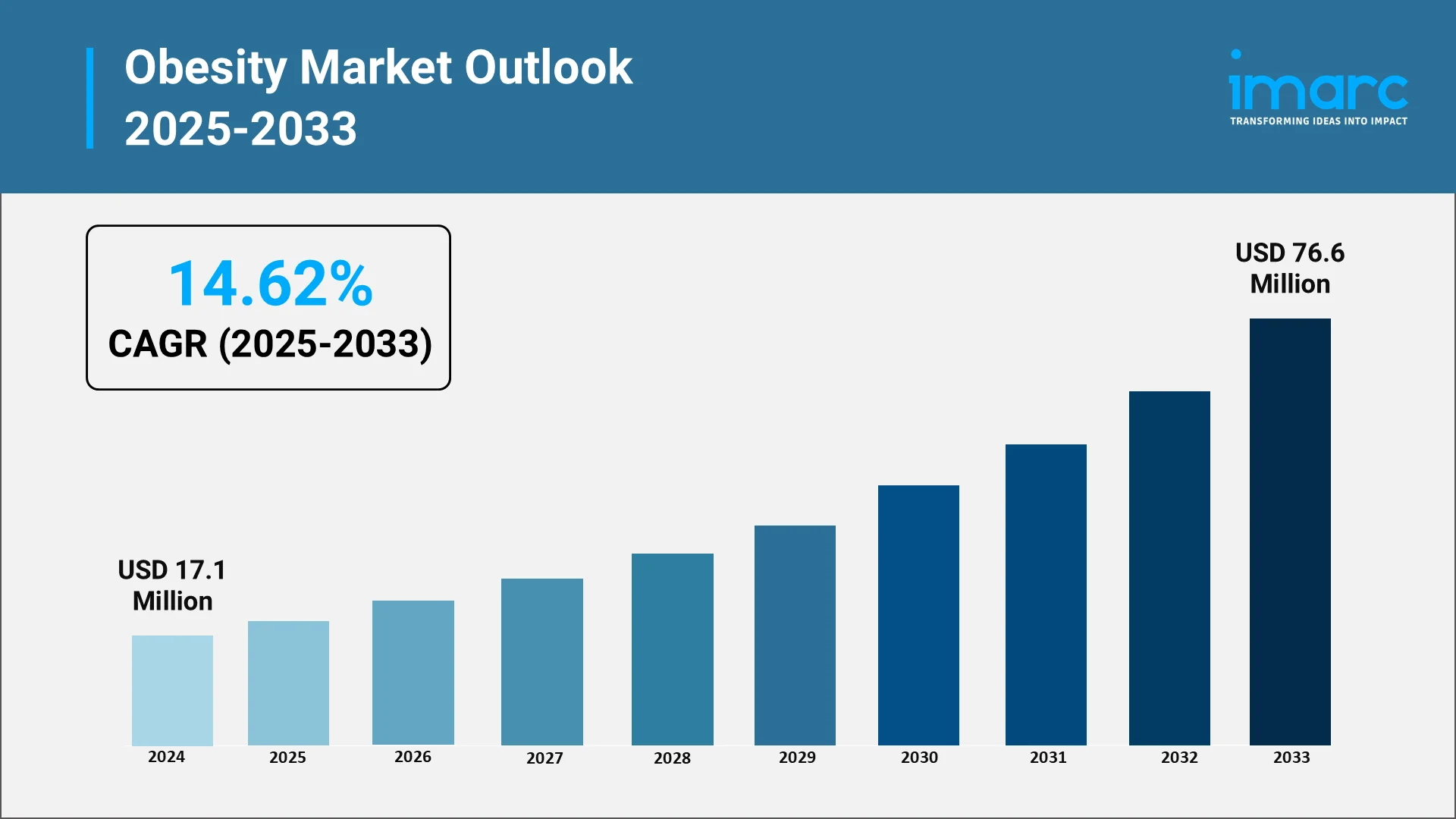The Future of Obesity Treatment: From Personalized Medicine to AI Solutions
.webp)
Introduction: Understanding the Global Challenge of Obesity
Obesity, once viewed primarily as a lifestyle choice, is now widely recognized as a complex and chronic disease characterized by excessive body fat accumulation. Its global prevalence is escalating at an alarming rate posing a significant and growing challenge to public health systems worldwide. Beyond the individual health risks such as type 2 diabetes, cardiovascular disease, and certain cancers, the economic burden of obesity is substantial, significantly driving up healthcare costs and diminishing workforce productivity.
Obesity rates have seen a dramatic rise worldwide, with statistics showing a marked increase in the number of individuals suffering from obesity, particularly in high-income nations. In 2024, the NCD Risk Factor Collaboration (NCD-RisC) reported over one billion individuals globally living with obesity, comprising nearly 880 million adults and 159 million children aged 5-19.
As these epidemic progresses, a robust market has emerged focusing on pharmaceuticals, medical devices, weight loss surgeries, and digital health platforms. This rapidly expanding sector seeks innovative solutions to address the physical, psychological, and societal impacts of obesity driving advancements in treatment options, technologies, and healthcare strategies worldwide.

Explore in-depth findings for this market, Request Sample
Obesity Drug Market: GLP-1 Agonists and the Rise of Weight Loss Therapies
The pharmaceutical sector has introduced breakthrough weight loss drugs targeting appetite suppression and fat absorption with a focus on personalized treatments based on genetic and health factors. For instance, in March 2025, Eli Lilly launched its diabetes and obesity management drug Mounjaro (tirzepatide) in India. The drug aims to enhance metabolic health.
Breakthrough Medications: New weight loss drugs, such as GLP-1 receptor agonists are providing more effective and sustainable weight loss options compared to traditional methods improving outcomes for patients and healthcare providers.
The future of obesity treatment will be heavily influenced by personalized medicine which tailors interventions based on an individual's genetic profile, lifestyle, and health conditions. Advances in genetic research are uncovering the biological mechanisms behind obesity allowing for targeted therapies that can offer more effective outcomes with fewer side effects.
For instance, in June 2025, Regeneron entered a strategic agreement with Hansoh Pharma to in-license a dual GLP-1/GIP receptor agonist currently in Phase 3 trials. This approach promises to revolutionize the way obesity is treated, making treatments more precise and better suited to individual needs.
Drug Development: AI and machine learning are crucial in discovering new drugs and treatment protocols for obesity. By analyzing vast amounts of biological data, these technologies help pharmaceutical companies target specific mechanisms of obesity, leading to more effective and targeted therapies with fewer side effects.
AI in Obesity Management: From Risk Stratification to Personalized Interventions
AI and ML are increasingly transforming the obesity market, significantly improving the way obesity is managed and treated. These technologies are contributing to the development of personalized treatment plans and innovative solutions in the following ways:
- Data Analysis: AI is used to analyze large datasets, such as patient health records, genetic data, and lifestyle habits, enabling healthcare providers to develop personalized treatment plans for obesity. This approach enhances treatment precision and improves patient outcomes by tailoring interventions to individual needs.
- Predicting Obesity Trends: Machine learning models scan demographic, lifestyle, and health information to forecast obesity trends down the line, helping public health agencies and organizations make informed decisions regarding interventions and resource distribution. AI and Big Data are playing increasingly critical roles in the obesity market, enabling the creation of tailored treatment programs and forecasting health outcomes.
For instance, in May 2025, Veradigm announced its use of AI on de-identified electronic health records to gain insights into GLP-1 receptor agonist therapies for diabetes and obesity by analyzing over 152 million records. This approach aims to improve patient outcomes and precision in obesity management.
How Consumer Demand for Weight Management is Shaping the Biopharma Landscape:
Growing awareness about obesity’s complex genetic, environmental, and behavioral causes has shifted its perception to that of a chronic medical condition. This evolving understanding, supported by scientific research and public health campaigns, highlights the serious health risks like diabetes, heart disease, and stroke. As a result, individuals and healthcare providers are focusing more on early diagnosis and intervention, with medical professionals increasingly encouraging treatment and improving care outcomes.
Individuals are also spending more on obesity management solutions, as out-of-pocket expenses for treatments, including weight loss drugs, surgical procedures, and fitness programs, continue to grow.
In India, Prime Minister Narendra Modi highlighted this issue, revealing that 24% of women and 23% of men are affected by obesity, according to NFHS-5 data. The government’s multi-sectoral response integrates health, nutrition, fitness, food safety, and regulatory actions. Key initiatives include the Fit India Movement, NP-NCD, POSHAN Abhiyaan, Eat Right India, and Khelo India, emphasizing community engagement, dietary reform, and physical activity.
Collectively, these programs aim to foster sustainable behavioral change, reduce obesity prevalence, and promote holistic wellness through policy innovation, awareness campaigns, and cross-ministerial collaboration.
Digital Therapeutics for Obesity: The Next Frontier in Chronic Disease Management
- Digital Health Platforms: AI significantly enhances digital health platforms, including fitness apps and wearables, by offering real-time feedback and personalized weight management strategies. For instance, in June 2025, MultiMedica launched BOOST, a tailored program that utilizes AI alongside a multidisciplinary healthcare team to address overweight and obesity. This initiative features customized exercise plans, remote monitoring, and educational resources, empowering patients to engage in their care from home. Such advancements improve accessibility and treatment outcomes for individuals seeking comprehensive obesity management.
- Digital Health Solutions: Digital health tools that incorporate real-time data, AI, and personalized recommendations empower individuals to manage obesity more effectively. These innovations allow for greater patient control and engagement in weight management programs. Telemedicine and remote health monitoring are rapidly gaining traction in the obesity market, enabling virtual consultations and weight tracking from home. For example, in February 2025, ORA Group introduced a hybrid weight management care model in Singapore, blending virtual and face-to-face consultations to tackle rising obesity rates affecting nearly 42% of the population.
Top 5 Pharma Companies Leading the Obesity Drug Pipeline:
These companies are at the forefront of developing innovative obesity treatments, each with unique approaches and promising candidates in their pipelines. The significant advancements in their ongoing clinical trials and anticipated regulatory filings are expected to fundamentally reshape the treatment landscape in the coming years.
Eli Lilly and Company
- Key Drug: Orforglipron
- Development Status: Phase 3 trials completed; regulatory submission anticipated by end of 2025.
- Highlights: Orforglipron is a daily oral GLP-1 receptor agonist demonstrating up to 12.4% weight loss over 72 weeks in clinical trials. The drug showed improvements in cholesterol, blood pressure, and heart disease risk factors.
Novo Nordisk
- Key Drug: CagriSema
- Development Status: Phase 3 trials underway; regulatory filing expected in 2026.
- Highlights: CagriSema shows significant weight loss: up to 22.7% in adults without diabetes and 15.7% in those with type 2 diabetes, based on two 68-week phase 3 studies (REDEFINE 1 and 2). In REDEFINE 1, participants lost an average of 20.4% with CagriSema versus 11.5% with cagrilintide and 3% with placebo; 40.4% achieved at least 25% weight loss.
Roche
- Key Drugs: CT-388 (GLP-1/GIP dual agonist), CT-996 (oral GLP-1 agonist)
- Development Status: Phase 1b trials for CT-388; Phase 1 trials for CT-996.
- Highlights: CT-388 demonstrated an average 18.8% weight loss over 24 weeks in early trials, positioning it as a potential "best-in-class" therapy. CT-996, an oral GLP-1 receptor agonist, showed a 7.3% weight loss over four weeks, indicating its efficacy as a convenient alternative to injectables.
Amgen
- Key Drug: MariTide (GLP-1/GIP dual agonist)
- Development Status: Phase 3 trials (MARITIME program) initiated.
- Highlights: In Phase 2 studies, MariTide achieved up to 20% weight loss in non-diabetic individuals and 17% in those with type 2 diabetes, without a plateau effect. The Phase 3 program seeks to conduct additional assessments of its long-term effectiveness and safety profile.
Boehringer Ingelheim
- Key Drug: BI 3034701 (triple receptor agonist)
- Development Status: Phase 1 trials initiated.
- Highlights: Developed in collaboration with Gubra, BI 3034701 targets GLP-1, GIP, and glucagon receptors to address obesity and related metabolic disorders. The Phase 1 study is assessing its safety, tolerability, and pharmacokinetics, with potential for once-weekly dosing.
Rising Obesity Rates in 7 Major Markets: Challenges and Market Opportunities
With the largest population affected by obesity, the United States also represents the most significant market for obesity treatment solutions. The country has an adult obesity rate of 42%. This surge is driven by multiple factors, including declining physical activity levels and greater access to unhealthy foods, which are contributing to an alarming increase in obesity rates.
As the prevalence of obesity continues to rise, healthcare systems worldwide are feeling the strain. Governments and private insurers are increasingly investing in obesity prevention and management programs, recognizing that addressing the condition early can reduce long-term healthcare costs. Obesity-related complications, such as diabetes, cardiovascular diseases, and joint problems, contribute to a substantial proportion of healthcare expenditures. By tackling obesity, governments aim to reduce these costs while improving public health outcomes.
Advancements in bariatric surgery, such as gastric balloon procedures and robotic surgery, have made surgical options more accessible and less intimidating for patients, contributing to an increased demand for these treatments. These innovations have also spurred the development of new technologies designed to enhance the surgical experience and improve patient outcomes.
For instance, in June 2025, Nitinotes received FDA IDE approval to launch a pivotal trial for its EndoZip™ System, an innovative automated suturing platform for endoscopic sleeve gastroplasty. The multicenter trial aims to enroll 184 patients to assess safety and efficacy. In the UK, 64.5% of adults were estimated to be overweight or obese in 2023-2024, with higher rates among men and in deprived areas, indicating a widespread issue.
Future Outlook:
The obesity market is on the cusp of a revolutionary transformation. With a projected value of USD 76.6 Million by 2035, the market is not just expanding—it's evolving into a more precise and accessible field of chronic disease management. Personalized medicine, powered by AI and data analytics, is enabling breakthroughs in targeted therapies. Digital therapeutics and remote monitoring are making treatment more convenient and effective, while a robust pipeline of new-generation drugs promises even more powerful and convenient solutions. The focus on prevention, early diagnosis, and tailored treatments will be the key to successfully combatting the rising obesity epidemic and driving unprecedented growth in the years ahead. The companies and technologies that can deliver truly integrated, patient-centric solutions will not only lead the market but also play a critical role in improving global public health outcomes.
How IMARC Group is Shaping the Future of the Expanding Obesity Market:
IMARC Group assists stakeholders in the growing obesity market by delivering strategic insights to navigate this dynamic landscape. Our services empower clients to uncover emerging opportunities, reduce risks, and foster innovation through in-depth market analysis, forecasting, and competitive intelligence, enabling them to stay ahead of trends and make informed, strategic decisions in the ever-evolving obesity space:
- Market Insights: Analysis of trends such as the rising prevalence of obesity, growing demand for treatments, and advancements in therapies like pharmaceuticals, surgery, and digital health solutions.
- Strategic Forecasting: Insights into key developments, including personalized treatments, regulatory changes, and AI in obesity management.
- Competitive Intelligence: Monitoring industry advancements, from new therapies to AI-driven personalized weight management.
- Policy and Regulatory Analysis: Understanding the impact of healthcare regulations and insurance coverage on obesity treatments.
- Customized Consulting Solutions: Tailored strategies to expand product offerings and stay competitive.
As the obesity market expands, IMARC Group offers vital insights to help stakeholders stay ahead. By providing in-depth market analysis, strategic forecasting, and competitive intelligence, we guide businesses in navigating emerging opportunities, regulatory changes, and innovative treatment solutions. Our tailored consulting services enable organizations to adapt, stay competitive, and make informed decisions, ensuring they lead in the rapidly evolving obesity market. For detailed insights, data-driven forecasts, and strategic advice, see the complete report here: https://www.imarcgroup.com/obesity-market-outlook
Our Clients
Contact Us
Have a question or need assistance?
Please complete the form with your inquiry or reach out to us at
Phone Number
+91-120-433-0800+1-201-971-6302
+44-753-714-6104
.webp)










